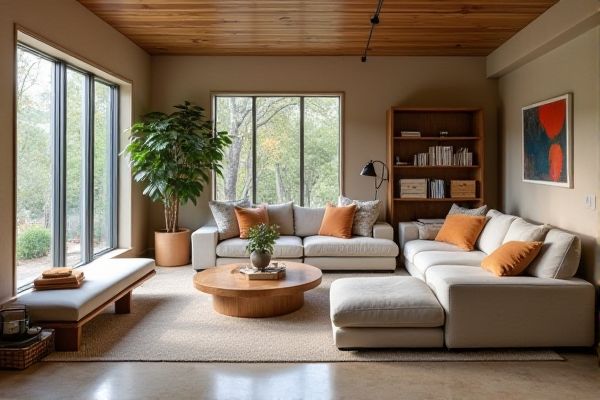
Flexible seating offers adaptable arrangements that can be easily reconfigured to support collaborative learning and accommodate diverse student needs, while fixed seating provides a structured environment with permanent furniture that often limits movement and customization. Explore the rest of the article to discover which seating option best suits your educational space and teaching style.
Table of Comparison
| Criteria | Flexible Seating | Fixed Seating |
|---|---|---|
| Definition | Movable chairs and desks allowing varied arrangements | Permanent desks and chairs fixed in one position |
| Comfort | Customizable for individual preferences | Standardized, limited comfort options |
| Space Utilization | Optimizes space with adaptable layouts | Less efficient, rigid room layout |
| Collaboration | Enhances teamwork and group activities | Restricts interaction; promotes individual work |
| Cost | Moderate to high, based on furniture quality | Typically lower, due to simpler setup |
| Maintenance | Requires frequent adjustments and cleaning | Lower maintenance, less movement |
| Flexibility | High; supports various learning styles | Low; fixed design limits adaptability |
| Ideal Use | Modern classrooms, collaborative workspaces | Traditional classrooms, lecture halls |
Introduction to Flexible vs Fixed Seating
Flexible seating offers adaptable arrangements that enhance collaboration and creativity by allowing users to choose their preferred spots, unlike fixed seating which provides a consistent, structured layout designed for predictability and order. Your choice between flexible and fixed seating impacts room functionality, influencing comfort, space utilization, and interaction dynamics. Understanding the benefits of each helps optimize environments for specific needs, whether prioritizing flexibility or stability.
Historical Evolution of Classroom Seating
Flexible seating has evolved as an innovative response to traditional fixed seating arrangements that dominated classrooms for centuries, designed primarily for teacher-centered instruction. Fixed seating remained popular through the Industrial Revolution and into the 20th century, emphasizing order and control, but educators recognized its limitations in fostering collaboration and student engagement. Your classroom environment benefits from flexible seating by embracing the shift toward learner-centered spaces, promoting movement, comfort, and adaptability that align with modern pedagogical strategies.
Key Features of Flexible Seating
Flexible seating offers adaptable arrangements that enhance collaboration and accommodate diverse learning styles. Key features include movable chairs and tables, varied seating options like bean bags and stools, and ergonomic designs that promote comfort and focus. This approach fosters an engaging environment by enabling frequent reconfiguration to suit different activities and group sizes.
Characteristics of Fixed Seating
Fixed seating features permanently anchored chairs or benches designed for stability and consistent arrangement, often made from durable materials like metal or hardwood. These seatings provide clear sightlines and organized layouts, ideal for auditoriums, theaters, and lecture halls where space optimization is critical. Your environment benefits from fixed seating's low maintenance and long-term durability, though it lacks the adaptability of flexible options.
Benefits of Flexible Seating in Modern Environments
Flexible seating enhances collaboration, creativity, and comfort by allowing individuals to choose seating arrangements that suit their work style and task. This adaptability promotes increased engagement, reduces physical strain, and supports dynamic activities in classrooms, offices, and public spaces. Your environment benefits from improved space utilization and a more inclusive atmosphere that fosters productivity and well-being.
Advantages of Traditional Fixed Seating
Traditional fixed seating offers consistent durability and structural stability, providing long-term cost efficiency in high-traffic environments such as theaters and auditoriums. Fixed seating ensures uniform organization, enhancing crowd control and maximizing space utilization through precise, permanent layouts. Its integration with built-in features like armrests and cup holders adds comfort and convenience tailored to specific venues' needs.
Challenges of Implementing Flexible Seating
Implementing flexible seating presents challenges such as maintaining classroom organization, ensuring equitable access to diverse seating options, and addressing potential distractions that impact student focus. Your ability to effectively monitor and manage varied seating arrangements plays a crucial role in maximizing engagement without compromising discipline. Moreover, initial costs for ergonomic furniture and ongoing maintenance require consideration to sustain a flexible learning environment.
Potential Drawbacks of Fixed Seating
Fixed seating limits adaptability in classroom layouts, hindering collaborative learning and personalized comfort. It often results in inefficient use of space and restricts movement, negatively affecting student engagement and posture. Your learning environment benefits more from flexible seating that accommodates diverse activities and learning styles.
Flexible Seating vs Fixed Seating: Student Engagement and Performance
Flexible seating enhances student engagement by promoting movement, collaboration, and personalized comfort, which can lead to improved focus and academic performance. Fixed seating often limits physical mobility and interaction, potentially reducing student motivation and participation in lessons. Your classroom environment benefits from flexible seating options that adapt to diverse learning styles and foster active, inclusive learning experiences.
Choosing the Right Seating Solution for Your Space
Flexible seating offers adaptable configurations that maximize space efficiency and enhance collaboration, making it ideal for dynamic environments such as classrooms and offices. Fixed seating provides stability and durability, suitable for auditoriums and theaters where consistent arrangement and capacity are priorities. Assessing factors like room size, intended use, and user comfort ensures selecting the best seating solution that aligns with functional and aesthetic goals.
 homyna.com
homyna.com